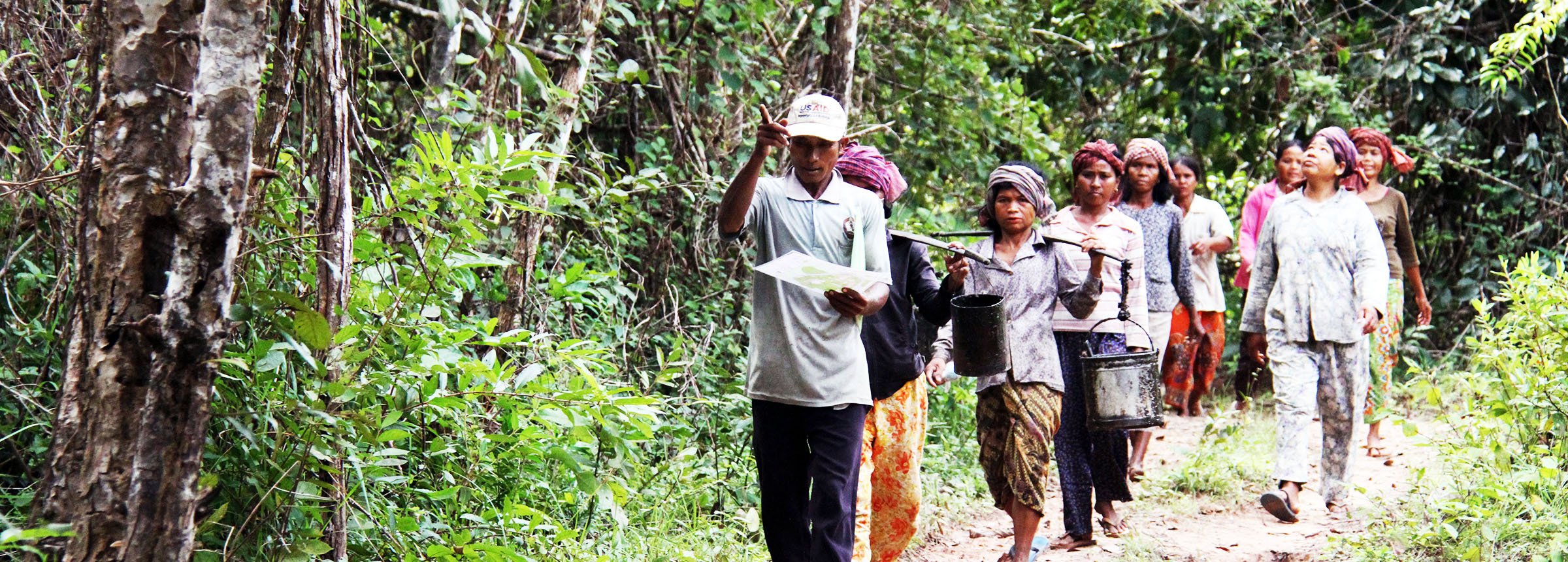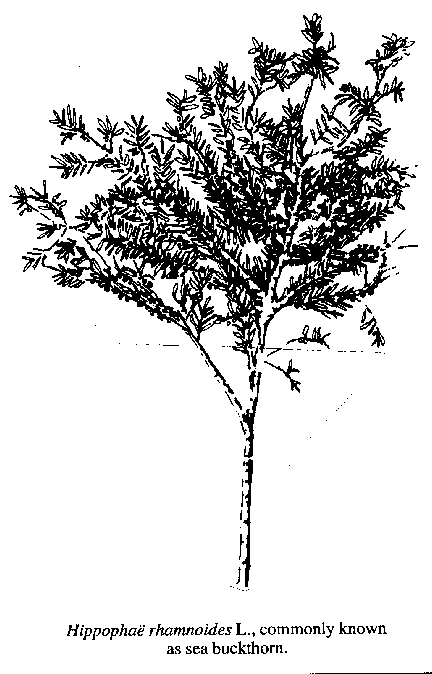
Hippophaë rhamnoides: an NFT valued for centuries
NFTA 93-02, June 1993
A quick guide to useful nitrogen fixing trees from around the world
Hippophaë rhamnoides L., commonly known as sea buckthorn, is an arborescent shrub of wide adaptability distributed throughout more than 20 countries of Europe and Asia. The species has a
history of utilization that goes back at least 12 centuries. An actinorhizal plant, sea buckthorn has the capacity to fix atmospheric nitrogen and thus enrich the soil. It is used successfully as a windbreak and to stabilize sand dunes, and several of its products have high value.
 Botany
Botany
Sea buckthorn is a deciduous shrub or small tree, with thorns and unisexual flowers. It is dioecious and wind pollinated. Its fruit is a drupe, reddish orange, varying in length from 5 to 12 mm, with a tart, bittersweet taste. Each fruit has one bone-hard seed. Shrubs usually begin to bear fruit after three years and give maximum yields after seven to eight years.
The trees have an extensive, shallow root system and root-suckering is common. Plants degenerate after approximately 15 years and then reproduce by suckering.
Rousi (1971) divided the genus Hippophaë into three species. More recently, Lian (1988) revised the taxonomy, dividing the genus into five species. Hippophaë rhamnoides is by far the most common and references to Hippophaë are usually to this species.
Ecology
Sea buckthorn grows anywhere in temperate latitudes, from sand dunes near the sea to the Eurasian plateau at 5200 m above sea level.
Plant characteristics vary considerably according to this wide range of climatic conditions. For instance, these “shrubs” can reach 18m in height in certain zones.
This is a light-demanding species. Trees growing in forested areas will die if the canopy density exceeds 50%. However, they are extremely drought tolerant, with extensive root systems that scavenge soil humidity and groundwater aggressively.
They grow readily in areas that receive as little as 250 to 800 mm of rainfall annually. For example, there is a large area of natural Hippophaë forest on the loess plateau of China, including the semi-arid regions of Shanxi, Shaanxi and Gansu Provinces.
The species is also well adapted to cold climates. There are 18,000 ha of natural Hippophaë forest in Siberia where the temperature commonly drops well below 0°C. Sea buckthorn is also tolerant of alkaline and saline soils. It is reported to grow in the Qaidam Basin of China where the salt content of the soil ranges from 0.6 to 1.1% and the pH is 9.5.
Distribution
Sea buckthorn is native to the temperate zones of Asia and Europe, where it is widely distributed. It is also well represented at higher altitudes in the sub-tropical zones of Asia. Russia has approximately 200,000 ha of natural Hippophaë forest plus more than 6,000 ha in plantations. With 920,000 ha, China has the largest area under Hippophaë of any country, and also the largest variety of Hippophaë species.
Uses
Food. Sea buckthorn fruit is rich in vitamins C, E, K, B1 and B2, as well as niacinamide, pantothenic acid, carotenoids and other substances such as oil, sugar, malic acid, amino acids and pectin. The vitamin C content of the Chinese sea buckthorn (Hippophaë rhamnoides subsp. sinensis Rousi) fruit can be as high as 1253 mg/100 g-1.
Numerous food products are made from the fruit of this species. For instance, sea buckthorn wine is well known in Russia. In that country,a new variety has been bred by hybridizing geographically distant plants: it produces as much as 10,000 kg/ha-1 of fresh fruits. In China, poor peasants have become prosperous by collecting and processing the fruit. Hippophaë leaves also contain various nutritious substances and minerals. They are commonly used as tea.
Medicine. There are records of the medicinal use of sea buckthorn as early as the eighth century A.D. The Tibetan medical classic, Four Books of Pharmacopeia, lists 84 prescriptions for the preparation of sea buckthorn medicines. According to one account, a Tibetan lama considered this plant as a general panacea and made extensive use of its roots, stems, leaves, flowers, fruits and seed. The plant was widely used as a folk medicine in ancient Greece, the Roman Empire, Mongolia and Russia. Oil from the fruit acts as an antioxidant and may thus be used to treat wounds, frost bite and pathological problems of the alimentary mucous membranes. Serotonin (5-hydroxy-tryptamine) extracted from sea buckthorn possesses antitumor capabilities.
Animal feed. The ancient Greeks named the genus Hippophaë,or “glittering horse,” because they believed that horses became plump and healthy when maintained on pastures with these trees. Today, herdsmen in northwest China often feed sea buckthorn leaves to their animals. In Russia, fodder supplements of sea buckthorn by-products are reported to improve liveweights and coat condition. Feeding poultry with meal made from sea buckthorn fruit and fruit oil has been observed to increase the pigmentation of egg yolks and body fat. The oil also increases flesh pigmentation in rainbow trout.
Ecological benefits. Hippophaë possesses a strong capacity to fix atmospheric nitrogen in its root nodules when associated with the actinomycete, Frankia. Most soils possess enough Frankia to support nodulation. In one stand on the east coast of England, annual nitrogen fixation was estimated as high as 179 kg-1/ha-¹ (Stewart and Pearson, 1967).
All of the plant’s characteristics, especially its strong nitrogen-fixing ability and rapid growth, make it a good species for improving soil fertility, controlling erosion, conserving water, and stabilizing sand dunes. In mixed plantings, it can promote the growth and development of adjacent plants. Sea
buckthorn also shows a strong tolerance for toxic pollutants in the soil and air. It can thus be used to revegetate heavily industrialized areas or to reclaim mining sites.
Other uses. Cosmetics derived from sea buckthorn are widely used in Romania, Russia and China. Massage creams, day creams and a shampoo developed in Romania have received international patents. In addition, the trees yield good-quality fuelwood. In China’s western Liaoning Province, a six-year-old sea buckthorn plantation can produce 6.32 t/ha of wood. Sea buckthorn is also useful as an ornamental shrub.
Silviculture
Management varies according to objectives and environment factors. The species propagates well asexually because lignified branches of any age possess a strong ability to form adventitious roots. Hippophaë rhamnoides can also be propagated from softwood cuttings under mist. For intro-duction or breeding trials, seed propagation is the most suitable treatment.
The seeds retain their viability after indoor storage for three to four years. Under suitable conditions, they will germinate during any season of the year. In 1977, a large plantation was successfully established on the loess plateau of China by broadcasting seed from aircraft.
Limitations
The wide adaptability and varied reproductive strategies of Hippophaë rhamnoides indicate that it could be a serious weed in some environments. Its extensive, suckering root system may make it unsuitable for agroforestry technologies that include close tree/crop associations. In addition, thorns on the stem and branches often make it difficult to harvest the fruits.
References
Lian Yongshan. 1988. New discoveries of the genus Hippophaë L. (Elaeagnaceae). Acta Phytotaxonomica Sinica. 26(3):235-37.
Rousi, A. 1971. The genus Hippophaë L: a taxonomic study. Annales Botanica Fennici. 8(3):177-277.
Stewart, W.D.P. and Pearson, M.C. 1967. Nodulation and nitrogen fixation by Hippophaë rhamnoides in the field. Plant and Soil. 26(2):348-60.
This issue was prepared by Dwight Baker, Lecturer and Associate Research Scientist, Yale University, New Haven, CT 06511, USA; current address: Senior Scientist, Panlabs Inc, 11804 North Creek Parkway South, Botheil, WA 98011-8805, USA.
A publication of the Forest, Farm, and Community Tree Network
